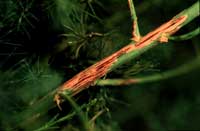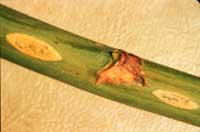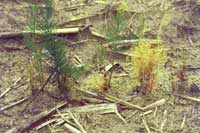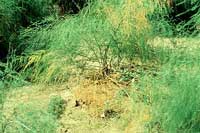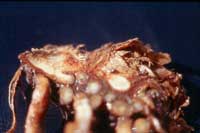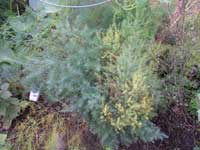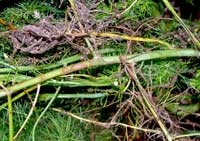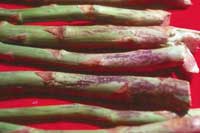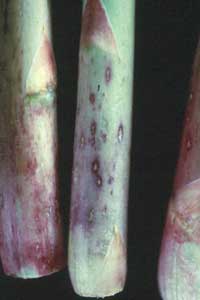Extension > Garden > Diagnose a problem > What's wrong with my plant? > Vegetable > Asparagus > Discolored fern
Asparagus > Fern > Discolored fern
1 of 4
Asparagus Rust
Puccinia asparagi
- No symptoms on spears
- Pale orange ovals on lower stems of fronds in spring
- In summer reddish brown, spots form on fronds and stems
- Reddish, rust-colored, powdery spores rub off on hands and equipment
- Spots turn black in fall
- Infected foliage dries and dies prematurely
- More information on Asparagus Rust
2 of 4
Fusarium Root and Crown Rot
Fusarium oxysporum f.sp. asparagi, Fusarium proliferatum
- Infected seedlings are stunted, yellow and may die
- Plants throughout field have a few yellow stunted shoots
- Overtime, plants decline
- Reddish brown lesions on lower stems and roots
- Crown develops a dry brown rot
- Older plants in low lying areas, or those stressed by drought or other factor are most severely affected
- More information on Fusarium Root and Crown Rot
3 of 4
Cercospora Leaf Spot
Cercospora asparagi
- Oval lesions with tan or gray center and reddish brown border
- Lower portion of ferns turn brown, eventually moving upward
- Entire fern may die by mid-season
- Amount of spears in the following year may be less
4 of 4
Purple Spot
Stemphylium vesicarium
- Oval lesions with tan or gray center and reddish brown border
- Lower portion of ferns turn brown, eventually moving up plant
- Entire fern may turn yellow and die by mid season
- Disease often most severe when plants are big enough to crowd one another
- More information on Purple Spot



